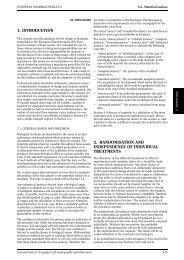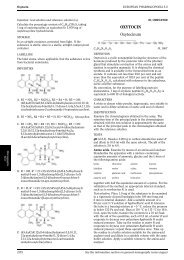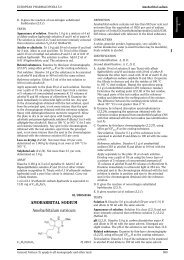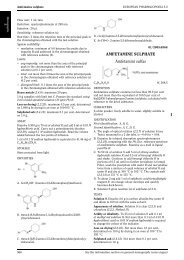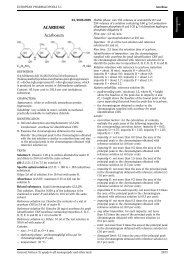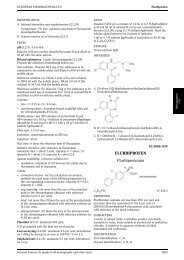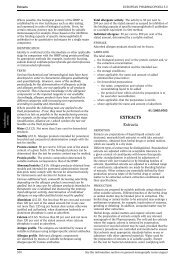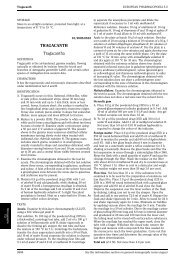EUGENOL Eugenolum
EUGENOL Eugenolum
EUGENOL Eugenolum
You also want an ePaper? Increase the reach of your titles
YUMPU automatically turns print PDFs into web optimized ePapers that Google loves.
EUROPEAN PHARMACOPOEIA 5.0 Eugenol<br />
— helium for chromatography R as the carrier gas at a flow<br />
rate of 1.5 ml/min,<br />
— a flame-ionisation detector,<br />
— a split ratio of 1:100,<br />
maintaining the temperature of the column at 60 °C for<br />
5 min, then raising the temperature at a rate of 5 °C/min to<br />
200 °C and maintaining at 200 °C for 5 min; maintaining<br />
the temperature of the injection port and that of the detector<br />
at 220 °C.<br />
Inject about 0.5 µl of the reference solution. When the<br />
chromatogram is recorded in the prescribed conditions the<br />
components elute in the order indicated in the composition<br />
of the reference solution. Record the retention times of<br />
these substances.<br />
Theassayisnotvalidunless:thenumberoftheoretical<br />
plates calculated for the peak due to limonene at 110 °C<br />
is at least 30 000; the resolution between the peaks<br />
corresponding to limonene and cineole is at least 1.5.<br />
Inject about 0.5 µl of the test solution. Using the<br />
retention times determined from the chromatogram obtained<br />
with the reference solution, locate the components of the<br />
referencesolutiononthechromatogramobtainedwiththe<br />
test solution.<br />
Determine the percentage content of these components by<br />
the normalisation procedure.<br />
The percentages are within the following ranges:<br />
— α-pinene: tracesto9.0percent,<br />
— β-pinene: less than 1.5 per cent,<br />
— α-phellandrene: less than 1.5 per cent,<br />
— limonene: tracesto12.0percent,<br />
— 1,8-cineole: minimum 70.0 per cent,<br />
— camphor: less than 0.1 per cent.<br />
STORAGE<br />
In a well-filled, airtight container, protected from light and<br />
at a temperature not exceeding 25 °C.<br />
<strong>EUGENOL</strong><br />
<strong>Eugenolum</strong><br />
01/2005:1100<br />
C10H12O2 Mr 164.2<br />
DEFINITION<br />
Eugenol is 2-methoxy-4-(prop-2-enyl)phenol.<br />
CHARACTERS<br />
A colourless or pale yellow, clear liquid, darkening on<br />
exposure to air, with a strong odour of clove, practically<br />
insoluble in water, freely soluble in alcohol (70 per cent V/V),<br />
practically insoluble in glycerol, miscible with glacial acetic<br />
acid, with alcohol, with fatty oils and with methylene<br />
chloride.<br />
IDENTIFICATION<br />
First identification: B.<br />
Second identification: A, C, D.<br />
A. It complies with the test for refractive index (see Tests).<br />
B. Examine by infrared absorption spectrophotometry<br />
(2.2.24), comparing with the spectrum obtained with<br />
eugenol CRS.<br />
C. Examinebythin-layerchromatography(2.2.27), using a<br />
TLC silica gel F254 plate R.<br />
Test solution. Dissolve 50 µl of the substance to be<br />
examined in alcohol R and dilute to 25 ml with the same<br />
solvent.<br />
Reference solution. Dissolve 50 µl of eugenol CRS in<br />
alcohol R and dilute to 25 ml with the same solvent.<br />
Apply to the plate 5 µl of each solution. Develop over a<br />
path of 15 cm using a mixture of 10 volumes of ethyl<br />
acetate R and 90 volumes of toluene R. Drytheplatein<br />
a current of cold air and examine in ultraviolet light at<br />
254 nm. The principal spot in the chromatogram obtained<br />
with the test solution is similar in position and size to the<br />
principal spot in the chromatogram obtained with the<br />
reference solution. Spray with anisaldehyde solution R.<br />
Heat at 100-105 °C for 10 min. The principal spot in the<br />
chromatogram obtained with the test solution is similar<br />
in position, colour and size to the principal spot in the<br />
chromatogram obtained with the reference solution.<br />
D. Dissolve 0.05 ml in 2 ml of alcohol R and add 0.1 ml<br />
of ferric chloride solution R1. A dark green colour is<br />
produced which changes to yellowish-green within 10 min.<br />
TESTS<br />
Relative density (2.2.5): 1.066 to 1.070.<br />
Refractive index (2.2.6): 1.540 to 1.542.<br />
Dimeric and oligomeric compounds. Dissolve 0.150 g of<br />
the substance to be examined in ethanol R and dilute to<br />
100.0 ml with the same solvent. The absorbance of the<br />
solution (2.2.25) at 330 nm is not greater than 0.25.<br />
Related substances. Examine by gas chromatography<br />
(2.2.28).<br />
Test solution. Dissolve 1.00 g of the substance to be<br />
examined in ethanol R and dilute to 5.0 ml with the same<br />
solvent.<br />
Reference solution (a). Dilute1.0mlofthetestsolutionto<br />
100.0 ml with ethanol R.<br />
Reference solution (b). Dissolve50mgofvanillin R in 1 ml<br />
of the test solution and dilute to 5 ml with ethanol R.<br />
The chromatographic procedure may be carried out using:<br />
— a fused-silica capillary column 30 m long and<br />
0.25 mm in internal diameter coated with a film of<br />
polymethylphenylsiloxane R (film thickness 0.25 µm),<br />
— helium for chromatography R as the carrier gas at a flow<br />
rate of 1 ml/min,<br />
— a flame-ionisation detector,<br />
— a split ratio of 1:40,<br />
Time<br />
(min)<br />
Temperature<br />
(°C)<br />
Rate<br />
(°C/min)<br />
Comment<br />
Column 0-2 80 isothermal<br />
2-27 80→280 8 linear gradient<br />
27 - 47 280 isothermal<br />
Injection port 250<br />
Detector 280<br />
Inject 1 µl of the test solution and 1 µl each of reference<br />
solutions (a) and (b). The test is not valid unless in the<br />
chromatogram obtained with reference solution (b), the<br />
relative retention time of the peak due to vanillin is at least<br />
1.1 with respect to the peak due to eugenol. Calculate the<br />
percentage content of related substances from the areas<br />
GeneralNotices(1)applytoallmonographsandothertexts 1571
Eugenol EUROPEAN PHARMACOPOEIA 5.0<br />
of the peaks in the chromatogram obtained with the test<br />
solution by the normalisation procedure; disregard the<br />
solvent peak and any peak with an area less than 0.05 times<br />
that of the principal peak in the chromatogram obtained<br />
with reference solution (a). The content of related substances<br />
with a relative retention time greater than 2.0 in respect to<br />
themainpeakisnotgreaterthan1.0percent;thecontent<br />
of any related substances is not greater than 0.5 per cent;<br />
the total content of related substances is not greater than<br />
3.0 per cent.<br />
Hydrocarbons. Dissolve 1 ml in 5 ml of dilute sodium<br />
hydroxide solution R and add 30 ml of water R in a<br />
stoppered test-tube. Examined immediately, the solution is<br />
yellow and clear (2.2.1).<br />
Sulphated ash (2.4.14). Not more than 0.1 per cent,<br />
determined on 1.0 g.<br />
STORAGE<br />
Store in a well-filled container, protected from light.<br />
IMPURITIES<br />
A. (1R,4E,9S)-4,11,11-trimethyl-8-methylenebicyclo[7.2.0]undec-4-ene<br />
(β-caryophyllene),<br />
B. (1E,4E,8E)-2,6,6,9-tetramethylcycloundeca-1,4,8-triene<br />
(α-humulene, α-caryophyllene),<br />
C. (1R,4R,6R,10S)-4,12,12-trimethyl-9-methylene-5oxatricyclo[8.2.0.0<br />
4,6 ]dodecane (β-caryophyllene oxide),<br />
D.R1=H,R2=H,R3=CH 2-CH=CH 2: 4-(prop-2-enyl)phenol,<br />
E. R1 = CH 3,R2=OCH 3,R3=CH 2-CH=CH 2:<br />
1,2-dimethoxy-4-(prop-2-enyl)benzene (eugenol methyl<br />
ether),<br />
F. R1=H,R2=OCH 3,R3=CH=CH-CH 3 (cis):<br />
2-methoxy-4-[(Z)-prop-1-enyl]phenol (cis-isoeugenol),<br />
G.R1=H,R2=OCH 3,R3=CH=CH-CH 3 (trans):<br />
2-methoxy-4-[(E)-prop-1-enyl]phenol (trans-isoeugenol),<br />
H.R1=H,R2=OCH 3, R3 = CHO: 4-hydroxy-3methoxybenzaldehyde<br />
(vanillin),<br />
I. R1=CO-CH 3,R2=OCH 3,R3=CH 2-CH=CH 2:<br />
2-methoxy-4-(prop-2-enyl)phenyl acetate (acetyleugenol),<br />
J. R1=H,R2=OCH 3,R3=CO-CH=CH 2:<br />
1-(4-hydroxy-3-methoxyphenyl)prop-2-enone,<br />
K.R1=H,R2=OCH 3, R3 = CH=CH-CHO:<br />
(E)-3-(4-hydroxy-3-methoxyphenyl)prop-2-enal<br />
(trans-coniferyl aldehyde),<br />
L. 2-methoxy-4-[3-methyl-5-(prop-2-enyl)-2,3dihydrobenzofuran-2-yl]phenol<br />
(dehydrodi-isoeugenol),<br />
M. 3,3′-dimethoxy-5,5′-bis(prop-2-enyl)biphenyl-2,2′-diol<br />
(dehydrodieugenol),<br />
N. O. two further unknown dimeric compounds,<br />
P. toluene.<br />
1572 See the information section on general monographs (cover pages)



